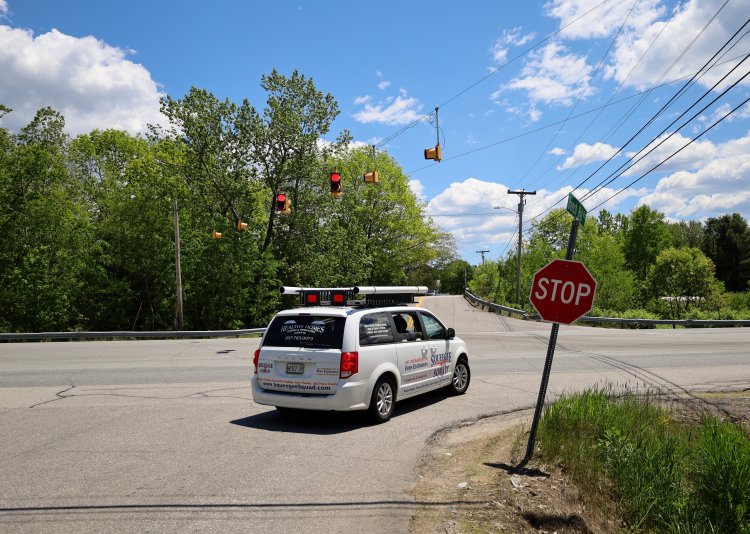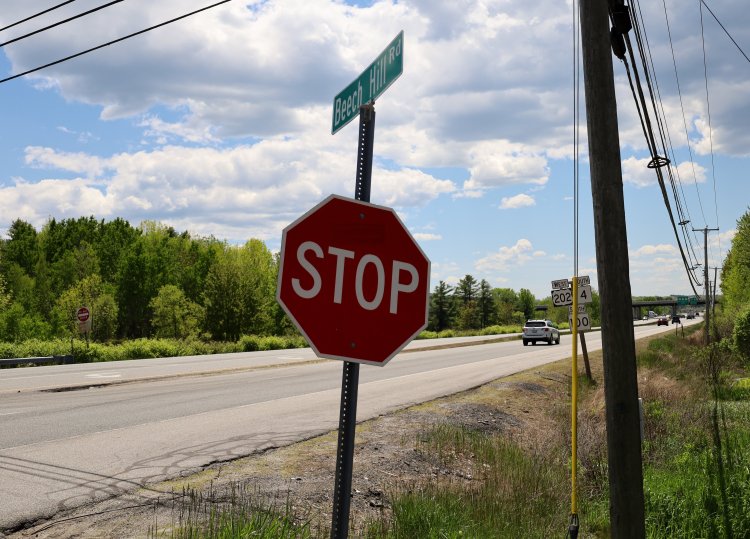
AUBURN — An intersection where a fatal crash occurred this month is among the most dangerous in Maine.
The intersection at Washington Street and Danville Corner and Beech Hill roads, where on May 14 two passengers traveling in a van owned by John F. Murphy Homes were killed after the vehicle was struck by a pickup truck, holds the top spot on a state database that ranks the likelihood of crashes resulting in fatal or serious injuries.
It’s been eyed for improvements — or a complete overhaul — for years. However, short-term fixes to address traffic safety have so far not occurred.
Flashing red lights signal traffic coming from Beech Hill and Danville Corner roads, while drivers on Washington Street don’t have a stop light.
City officials last year considered working with the Maine Department of Transportation on a demonstration project to place concrete barriers and safety barrels at the intersection to prevent vehicles from crossing Washington Street, which is state Route 202.
However, the project stalled because councilors couldn’t agree on what to do at the intersection, with the state also proposing to install a traffic light there.
Some constituents and elected officials also worried about the demonstration project’s impact on nearby intersections, so officials instead sought public feedback through a consultant who was hired to study the entire Washington Street corridor. Those findings will be presented to the council in June.
In the meantime, however, the city is forced to answer questions about a lack of short-term solutions for one of the most dangerous intersections in Maine.
The demonstration project would have prevented the kind of turn that led to the May 14 crash, and if approved in September, would’ve been installed this spring.
However, officials said the two-year demonstration would’ve delayed or canceled the traffic light project, and the council did not want to proceed without public input.
City Manager Phil Crowell said the council “had heard feedback from the public for and against,” and “they wanted more public engagement.”
Jeremiah Bartlett, a traffic engineer who is chairman of the L-A Complete Streets Committee, said after the May 14 accident, when he saw the intersection ranked first on the state’s database, it “froze my blood, to be honest.”
“We know everyone’s been talking about this, but we’re at the point where we’ve been talking an awfully long time, and it’s still the status quo there,” he said.
Bartlett said the Complete Streets Committee will discuss the intersection during its next meeting, but the committee is only advisory in nature and is limited to making recommendations to the city councils in both cities.
“At the end of the day for me, I’m just focused on what can be done now,” he said. “The reality is this is an intersection with very particular challenges. We know what the data is telling us and the data doesn’t lie.”
The MDOT database is a GIS-based tool that screens intersections for the likelihood of fatal and serious injury crashes — known as “K” and A” incidents, respectively — based on crash history at the location. The ranking is based on data through 2024, which means it doesn’t include this year’s fatal accident.
Reached this week, Mayor Jeff Harmon said there was a two-year period between when Auburn staff first talked to the transportation department about a demonstration project and when they were finally asked to move forward in August 2024. By that time, he said, the city had been informed by the state that a traffic signal at the intersection would be warranted based on analysis of the crash data.
Harmon said that because councilors were undecided on which way to go with the project, the city could instead gather public opinion through its larger visioning work for the Washington Street corridor.
“The council didn’t want to move ahead with anything last fall without gathering more public information,” he said.
During a subsequent public session, Harmon said he argued against the demonstration project because he believed it would divert traffic to other nearby intersections that are also considered high-crash locations.

Harmon said the council will take the feedback and recommendations from its consultant, Gorrill-Palmer, and will decide where to go. If it decides to do nothing, the state is still moving ahead with the traffic signal, he said.
Asked if there are any safety improvements the city can consider in the short-term, Harmon said city staff has been in discussions, but the council will again discuss the issue soon.
“I think the council should look at the actual crash data, understanding that there are a lot of dangerous intersections, and not necessarily taking action just because this fatal accident occurred,” he said. “But, I don’t think doing nothing is the answer. We need to look at the data and come up with a plan to reduce the crash risk there.”
Crowell said concept designs specific to the Beech Hill and Danville Corner intersection will be presented to the City Council in June.
According to Eric Cousens, director of public services, the Washington Street corridor study is a $155,700 project between Gorrill-Palmer and the Androscoggin Transportation Resource Center. The city has also spent about $15,000 of a $30,000 contract for the design of the demonstration project.
Bartlett, who commutes along the Route 202 corridor, called it a “stress-inducing area.”
He said Washington Street was designed as a high-speed connection between the Maine Turnpike and downtown Auburn, and essentially operates as a highway despite its 50 mph speed limit. Motorists turning off Beech Hill or Danville Corner roads are forced to make decisions from a stop while traffic on Washington is traveling 60-70 mph.
Bartlett said given the rate of travel and its purpose as an efficient corridor, he’s not convinced that a traffic signal will solve the safety issues either. Motorists traveling at high speeds will suddenly have to stop for a light, he said.
Part of the overall discussions about the Washington Street corridor have centered on whether to turn both the northbound and southbound sides into two-way traffic — northbound as a more typical city street, and southbound for through traffic.
At least the previous two comprehensive plans for the city have identified the corridor as an important gateway to welcome people into the city, but said its attractiveness and safety need to be addressed.
However, an overhaul of the Washington Street corridor, if approved, would be years away.
“That feels like a long time away for a problem that’s going on right now,” Bartlett said.


We invite you to add your comments. We encourage a thoughtful exchange of ideas and information on this website. By joining the conversation, you are agreeing to our commenting policy and terms of use. More information is found on our FAQs. You can modify your screen name here.
Comments are managed by our staff during regular business hours Monday through Friday as well as limited hours on Saturday and Sunday. Comments held for moderation outside of those hours may take longer to approve.
Join the Conversation
Please sign into your Sun Journal account to participate in conversations below. If you do not have an account, you can register or subscribe. Questions? Please see our FAQs.